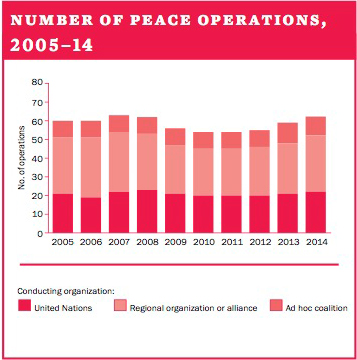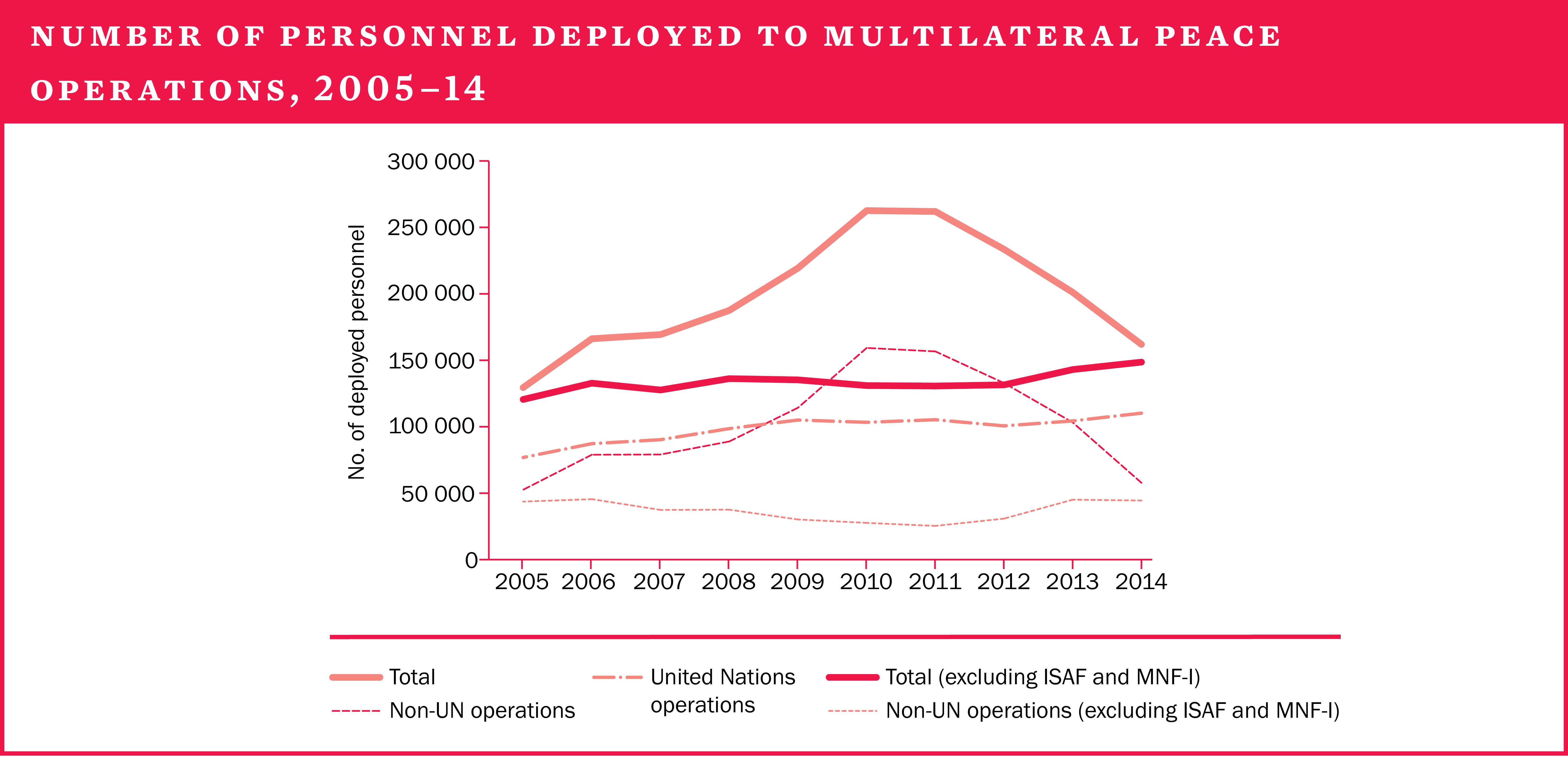5. Peace operations and conflict management
Summary
Many of the trends related to peace operations and conflict management in 2013 continued in 2014: the number of peace operations further increased, while the total number of personnel deployed again decreased. According to SIPRI data, there were 62 peace operations in 2014, a rise of 3 over the previous year. The number of deployed personnel in all peace operations, including the International Security Assistance Force (ISAF) in Afghanistan, fell by 20 per cent to 162 052. However, excluding ISAF, the total number of deployed personnel increased by 4 per cent to 148 716—a new record high. The closure of ISAF was a defining moment for 2014 and influenced many of the year’s peace operation-related figures.
As a consequence of ISAF’s drawdown, peace operations in Africa came into even greater focus: Africa is the continent with the largest number of such operations and hosts more personnel than all the other regions combined. Seven new peace operations were launched in 2014 and four of them were in Africa. The three new missions outside Africa were all established in response to the conflict in Ukraine.
Non-traditional and traditional challenges to peace operations
The non-traditional challenges faced by peace operations became increasingly prominent during the year. The African Union Mission in Somalia (AMISOM) and ISAF continued to face asymmetric threats from non-state actors, while the UN Disengagement Observer Force (UNDOF) in the Golan Heights and the UN Multidimensional Integrated Stabilization Mission in Mali (MINUSMA) became targets of jihadist groups. Another challenge was the Ebola epidemic, which especially affected the UN Mission in Liberia (UNMIL). A third non-traditional challenge was that several UN missions faced popular demonstrations, some of which even resulted in the death of protestors at the hands of mission personnel.
Peace operations also continued to operate in contexts of more traditional challenges, among them the rising tensions related to larger geopolitical changes and struggles. Such conflicts arose in Ukraine, for example, where Russia and the West struggled over geopolitical influence. Meanwhile, China’s increasingly robust contributions to UN peace operations have been partly explained as a means for protecting Chinese energy interests in Africa.
Peace operations seem to have become more robust, with a number of UN missions actively involved in combat in Africa. At the same time, the UN and its troop contributors came under closer scrutiny. For example, a troop contributor (the Netherlands) was, for the first time, held liable for the death of civilians (in Srebrenica, Bosnia and Herzegovina, in 1995).

Peace operations as a conflict management tool
Despite these challenges and the frequent criticism of operations and their effectiveness, the international community and conflict parties continue to view peace operations as a useful conflict management tool. Proposals for new operations in 2014 included some of the most difficult situations. Ukrainian parliamentarians and certain UN Security Council members hoped to deploy a UN peace operation to Ukraine, while pro-Russian activists wanted a Russian peacekeeping force. President Mahmoud Abbas of the Palestinian Authority proposed a North Atlantic Treaty Organization (NATO) operation to patrol a future Palestinian state and, towards the end of the 2014 Gaza War, the European Union (EU) repeated its offer to reactivate its Border Assistance Mission for the Rafah Crossing Point (EU BAM Rafah). Further, the Syrian opposition called for a UN mission to observe a future ceasefire, while some hoped that the UN would send a rescue mission to liberate schoolgirls kidnapped from Chibok, Nigeria, by Boko Haram.
In light of increasingly demanding missions, high expectations and a changing geopolitical environment, the UN Secretary-General announced a comprehensive review process for UN peace operations. A High-Level Panel on Peace Operations was appointed to assess the current state and future needs of peace operations. In undertaking this important yet difficult endeavour, the Panel could look at the core recommendations of the Brahimi Report, many of which are still valid today. If the Panel’s efforts would contribute to the implementation of at least some of these recommendations, it would already mark a great leap forward.
